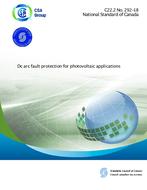CSA C22.2 NO. 292-18
Preface
This is the first edition of CSA C22.2 No. 292, Dc arc fault protection for photovoltaic applications, one of a series of Standards issued by CSA Group under Part II of the Canadian Electrical Code. This Standard is intended to replace the requirements previously contained in CSA TIL M-07. Arc fault protective devices are often embodied in combination with another device. As such, the user of this Standard may need to reference additional requirements as found in CSA C22.2 No. 5, CSA C22.2 No. 144.1, CSA C22.2 No. 21, CSA C22.2 No. 42, or elsewhere, as applicable. For general information on the Standards of the Canadian Electrical Code, Part II, see the Preface of CAN/CSA-C22.2 No. 0, General Requirements ? Canadian Electrical Code, Part II.
Scope
1.1 This Standard applies to dc arc fault protective devices (DC-AFPDs) and devices incorporating arc fault circuit protection intended for use in direct current circuits in photovoltaic (PV) systems having a maximum voltage rating of 1000 V dc and intended for installation in accordance with the rules of the Canadian Electrical Code, Part I. 1.2 This Standard contains construction, test, and marking requirements for DC-AFPDs and is designed to be used in conjunction with CSA CAN/CSA-C22.2 No. 5, CSA C22.2 No. 144.1, CSA C22.2 No. 305, and CSA C22.2 No. 107.1 as applicable. 1.3 A DC-AFPD is intended to detect and mitigate the effects of arcing faults that can pose a risk of fire ignition under certain conditions if the arcing persists. A DC-AFPD is not intended to detect glowing connections. 1.4 In this Standard, “shall” is used to express a requirement, i.e., a provision that the user is obliged to satisfy in order to comply with the standard; “should” is used to express a recommendation or that which is advised but not required; and “may” is used to express an option or that which is permissible within the limits of the Standard. Notes accompanying clauses do not include requirements or alternative requirements; the purpose of a note accompanying a clause is to separate from the text explanatory or informative material. Notes to tables and figures are considered part of the table or figure and may be written as requirements. Annexes are designated normative (mandatory) or informative (non-mandatory) to define their application.
Product Details
- Edition:
- 1st
- Published:
- 01/01/2018
- ISBN(s):
- 9781488311734
- Number of Pages:
- 50
- File Size:
- 1 file , 1.8 MB
